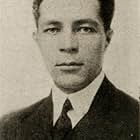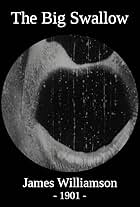Jack tells two people, privately, on a blind date that each of them is hard of hearing and wacky hijinks ensue.Jack tells two people, privately, on a blind date that each of them is hard of hearing and wacky hijinks ensue.Jack tells two people, privately, on a blind date that each of them is hard of hearing and wacky hijinks ensue.
Featured reviews
Edward Boulden complains that he knows no one in New York. Arthur Housman offers to introduce him to Nellie Grant -- but first tells each privately that the other is deaf.
Edison produced several short talking pictures, which he called Kinetophones, in 1913, but they never caught on. Largely forgotten, they languished for a century, but eight of them have recently been issued on DVD by Undercrank Productions in Cooperation with the Library of Congress and Greenbriar Picture Show.
All five of the actors in this movie were regulars at the Edison Studio. Housman would have a long career in the movies, specializing in comic drunks in the 1930s. This appearance marks him as the first comic in the talking pictures!
Like many of the short comedies of the era, it's a simple practical joke. Even so, it's amusing for its age, its historic importance and the fact that everyone talks very loudly even in the sequences when people are not trying be hear by people they think are deaf -- the sound equipment was not yet that good.
Edison produced several short talking pictures, which he called Kinetophones, in 1913, but they never caught on. Largely forgotten, they languished for a century, but eight of them have recently been issued on DVD by Undercrank Productions in Cooperation with the Library of Congress and Greenbriar Picture Show.
All five of the actors in this movie were regulars at the Edison Studio. Housman would have a long career in the movies, specializing in comic drunks in the 1930s. This appearance marks him as the first comic in the talking pictures!
Like many of the short comedies of the era, it's a simple practical joke. Even so, it's amusing for its age, its historic importance and the fact that everyone talks very loudly even in the sequences when people are not trying be hear by people they think are deaf -- the sound equipment was not yet that good.
Vaudeville in its heyday offered not only variety performers such as singers, jugglers, magicians, etc., but also one-act plays. These could be dramatic tear-jerkers or comic sketches, but one thing they all needed to be was simple. That is, they required a basic situation, easy to grasp quickly, with a sharp payoff. This fascinating short "Jack's Joke," made as an experimental sound short way back in 1913, is a prime example of the sort of playlet one might see in a vaudeville house at the time.
Edward Boulden plays Jack, an inveterate practical joker. When he bumps into his college chum Ned, who is visiting New York and lonely, he brings him to the home of his sweetheart Bess, then decides to play a prank on them both. Jack tells each one separately that the other is deaf, then leaves them alone together. Ned and Bess take turns shouting at one another, until finally Bess' Aunt Jane enters, and all is revealed. But Ned and Bess turn the tables on Jack by going off together to see a show, leaving him alone. "Stung!" he exclaims, as he sinks down into a chair.
Although the prank itself -- like many practical jokes -- is in dubious taste, this premise works well as a comic notion, and is ideal for the primitive recording equipment used by the Edison Studio to make this short. The players give us an interesting sample of what stage acting of the era looked like. Special casting note: Ned is played by Arthur Housman, familiar to film buffs from his many appearances in short comedies and features of the '30s, almost always as a comic souse. Here he's amazingly youthful, sober and clear-eyed.
A new edition of this short, restored by the Library of Congress along with several other Edison Kinetophone films of the period, is available on DVD from Undercrank Productions, in association with Greenbriar Picture Shows.
Incidentally, the skit offers an ironic remark at one point, when Bess (still under the impression Ned is deaf) expresses surprise that he likes to go to stage shows: "I should think you would enjoy motion pictures." Why? Because they're silent!
Edward Boulden plays Jack, an inveterate practical joker. When he bumps into his college chum Ned, who is visiting New York and lonely, he brings him to the home of his sweetheart Bess, then decides to play a prank on them both. Jack tells each one separately that the other is deaf, then leaves them alone together. Ned and Bess take turns shouting at one another, until finally Bess' Aunt Jane enters, and all is revealed. But Ned and Bess turn the tables on Jack by going off together to see a show, leaving him alone. "Stung!" he exclaims, as he sinks down into a chair.
Although the prank itself -- like many practical jokes -- is in dubious taste, this premise works well as a comic notion, and is ideal for the primitive recording equipment used by the Edison Studio to make this short. The players give us an interesting sample of what stage acting of the era looked like. Special casting note: Ned is played by Arthur Housman, familiar to film buffs from his many appearances in short comedies and features of the '30s, almost always as a comic souse. Here he's amazingly youthful, sober and clear-eyed.
A new edition of this short, restored by the Library of Congress along with several other Edison Kinetophone films of the period, is available on DVD from Undercrank Productions, in association with Greenbriar Picture Shows.
Incidentally, the skit offers an ironic remark at one point, when Bess (still under the impression Ned is deaf) expresses surprise that he likes to go to stage shows: "I should think you would enjoy motion pictures." Why? Because they're silent!
Years ago, I was lucky enough to get a copy of the original "Jazz Singer" along with its special features. I say lucky because the special features mostly consisted of many, many early sound experimental films...and I loved them. However, I had no idea that the Edison company also made some wonderful early sound films and was thrilled when I discovered "Jack's Joke" on YouTube.
The story is pretty simple. Jack sets up a couple on a blind date and has fun at their expense. He privately tells each that the person they are going to meet is extremely hard of hearing and so both talk very, very loudly when they meet. After a bit, however, they realize that Jack is having fun with them...and it all seems to be taken in stride.
Considering the film was made in 1913, it was amazing. Sure, there was a loud hissing sound over the voices (probably due to a scratchy recording due to time)....but even so, it was amazing and was synchronized with the picture very well. A really cute and well made experiment.
By the way, one of the actors is Arthur Housman...a guy was was very famous in the 1920s and 30s playing drunks and did so in some of Laurel & Hardy's films.
The story is pretty simple. Jack sets up a couple on a blind date and has fun at their expense. He privately tells each that the person they are going to meet is extremely hard of hearing and so both talk very, very loudly when they meet. After a bit, however, they realize that Jack is having fun with them...and it all seems to be taken in stride.
Considering the film was made in 1913, it was amazing. Sure, there was a loud hissing sound over the voices (probably due to a scratchy recording due to time)....but even so, it was amazing and was synchronized with the picture very well. A really cute and well made experiment.
By the way, one of the actors is Arthur Housman...a guy was was very famous in the 1920s and 30s playing drunks and did so in some of Laurel & Hardy's films.
... I just didn't realize that they seemed so natural and even modern.
I saw this on somebody's youtube channel and at first thought the entire thing was some kind of hoax by some group of people trying to duplicate the look and feel of the kinetophone films. Nope, this actually was a kinetophone film, struck from the original negative, so it looked realistic.
The "joke" is that Jack introduces his friend to a young lady, yet to arrive as being beautiful and rich, but also being very deaf but self conscious about it. Separately, he tells the young lady that his friend is very deaf but self conscious.
After they meet and Jack leaves the room, the pair proceed to shout at one another. Each thinks that the other is shouting because they are deaf.
Arthur Houseman, who plays Jack's friend, often played the drunk in early short films. Sadly enough, Houseman was an actual alcoholic.
Edison actually was deaf by this time in his life, and so it is odd his film company made deafness the object of the short film's joke.
I saw this on somebody's youtube channel and at first thought the entire thing was some kind of hoax by some group of people trying to duplicate the look and feel of the kinetophone films. Nope, this actually was a kinetophone film, struck from the original negative, so it looked realistic.
The "joke" is that Jack introduces his friend to a young lady, yet to arrive as being beautiful and rich, but also being very deaf but self conscious about it. Separately, he tells the young lady that his friend is very deaf but self conscious.
After they meet and Jack leaves the room, the pair proceed to shout at one another. Each thinks that the other is shouting because they are deaf.
Arthur Houseman, who plays Jack's friend, often played the drunk in early short films. Sadly enough, Houseman was an actual alcoholic.
Edison actually was deaf by this time in his life, and so it is odd his film company made deafness the object of the short film's joke.
Did you know
- TriviaIn June -July 1936, the film was shown as part of an exhibit of Edison "Kinetophone" equipment and exhibition materials at the New York Museum of Science and Industry in the RCA building in New York City, being described at the time as "the first talking picture made." (New York Sun, 26 June 1936)
Details
- Runtime6 minutes
- Color
- Aspect ratio
- 1.33 : 1
Contribute to this page
Suggest an edit or add missing content








